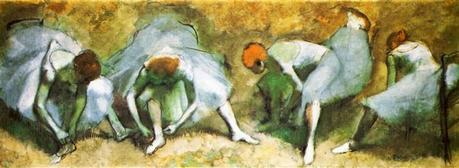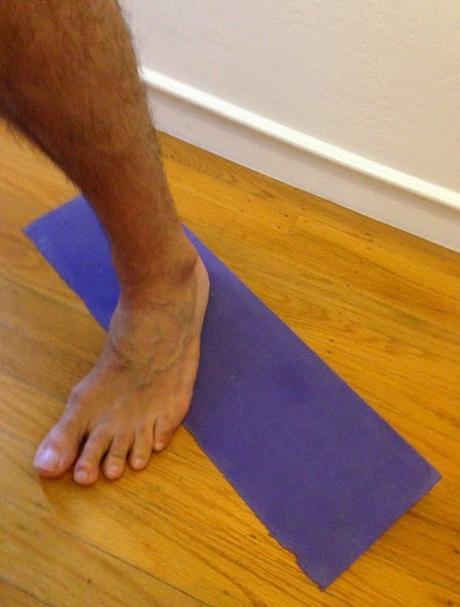
Dancers Tying Shoes by Edgar Degas
Q: I have been asked by a person who wants to try yoga for the first time if she can do yoga with her shoes on, as she finds her balance is not at all good without ankle support due do an injury in the past. She had broken her ankle and leg and her foot faces outward at an angle.A: The simplest answer is: Yes, of course! There have been numerous occasions when a student of mine, for one reason or another, needed to wear some sort of shoe/sandal/slipper in order to safely participate in class, especially when they were dealing with a painful foot condition of some sort. Why, just last night I had a young student show up for class with a two-day-old ankle sprain wanting to take class. The ankle was wrapped heavily in an ace bandage, which of course limited his flexion and extension at the ankle joint quite a bit. Despite these limitations—and with some timely suggestions from me throughout the class—he was able to successfully take class without removing his ankle support. I recall a time when one of my own feet was painful enough, likely from a mild case of plantar fasciitis, so that I had to wear flip-flops while teaching yoga in order to eliminate the pain and allow me to do my job of moving about the studio during classes. One of my teacher trainees also developed pain in both her feet and was advised by her doctor to wear low tennis shoes and not go barefoot for at least six months. She purchased a dedicated pair of shoes she only wore in the studio (so as to keep them and the wood floor clean), and was able to continue her yoga studies and take yoga classes as the feet healed.A friend of mine, a long-time yoga teacher, found out a few years back that she had a leg-length discrepancy (see Friday Q&A: One Leg Shorter than the Other for general info on this issue), which was causing her pain in her legs and hips. Her health care person suggested she wear a thin, customized sandal on the foot of her shorter leg when she is doing standing poses, and while she is standing and teaching. Since then, her pain has gone away and she continues to wear the sandal now for many years. Now, getting back to your student with the ankle and foot issues, you may need to do more than okay her to wear a dedicated pair of shoes to class. To allow her to experience poses with safe and helpful alignment, you may need to really creative in modifying standing poses by using other props. One of my favorite tools for this is the yoga wedge, which can be placed under the heel or ball of the foot as needed to deal with stiffness or immobility of the ankle joint It often helps with balance in poses like Triangle pose (Trikonasana) and Extended Side Angle pose (Utthita Parsvakonasana).


